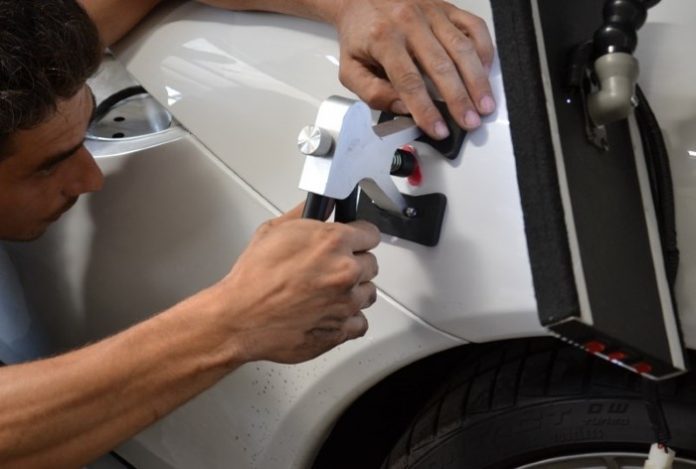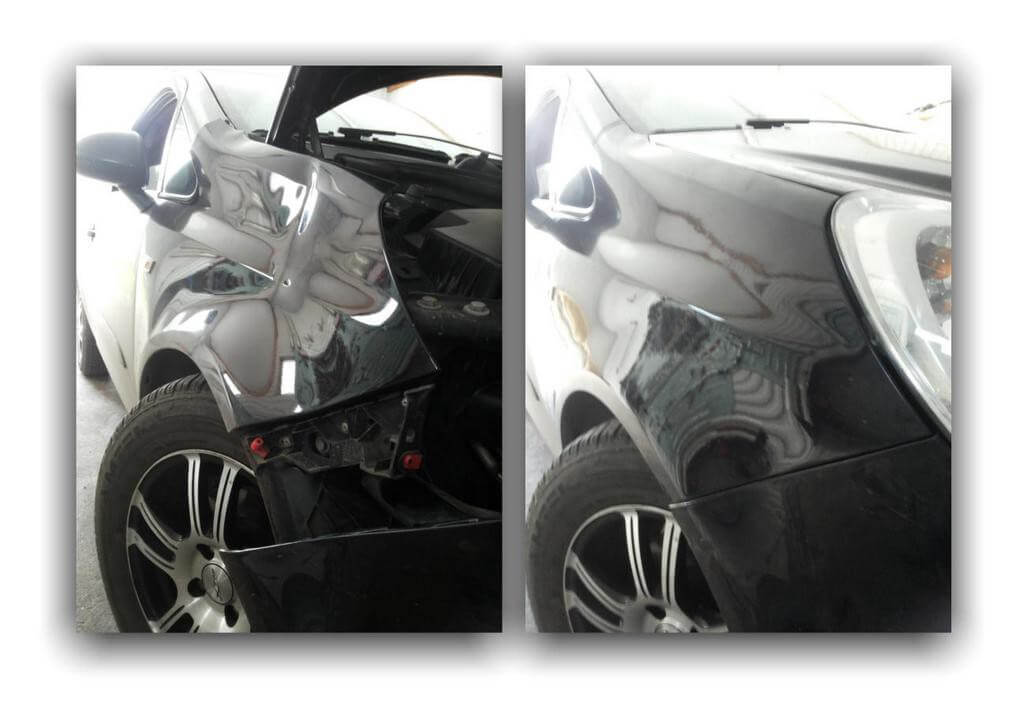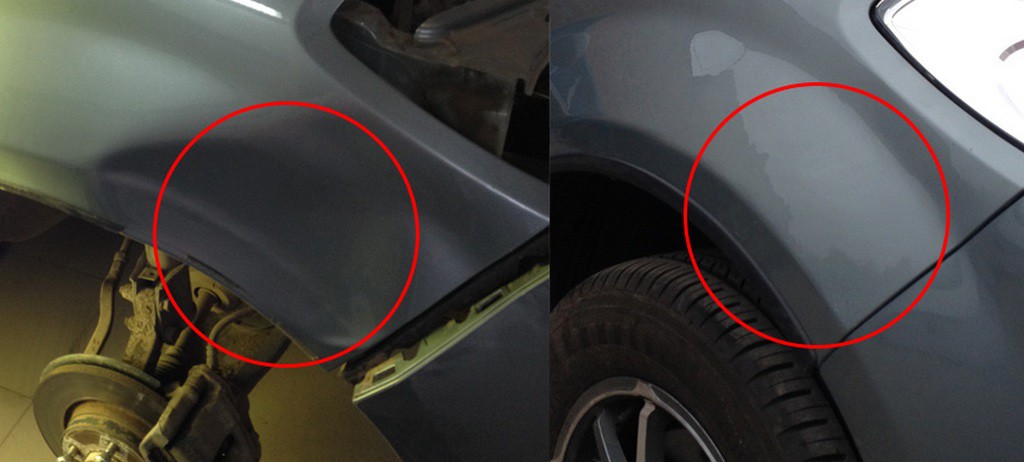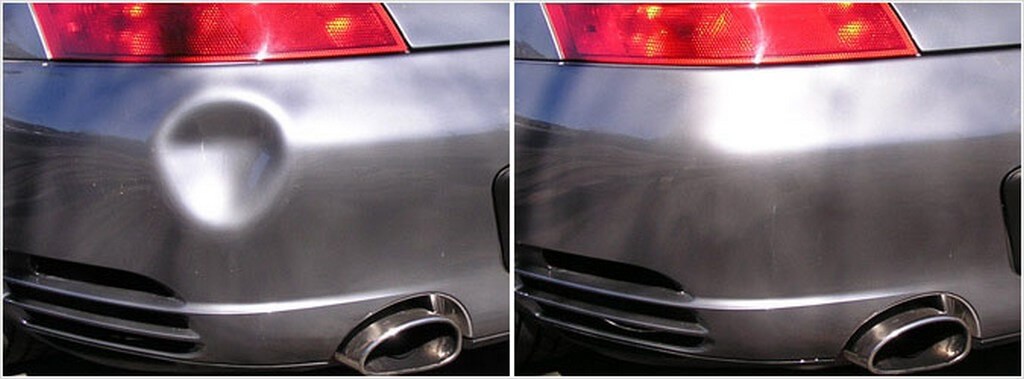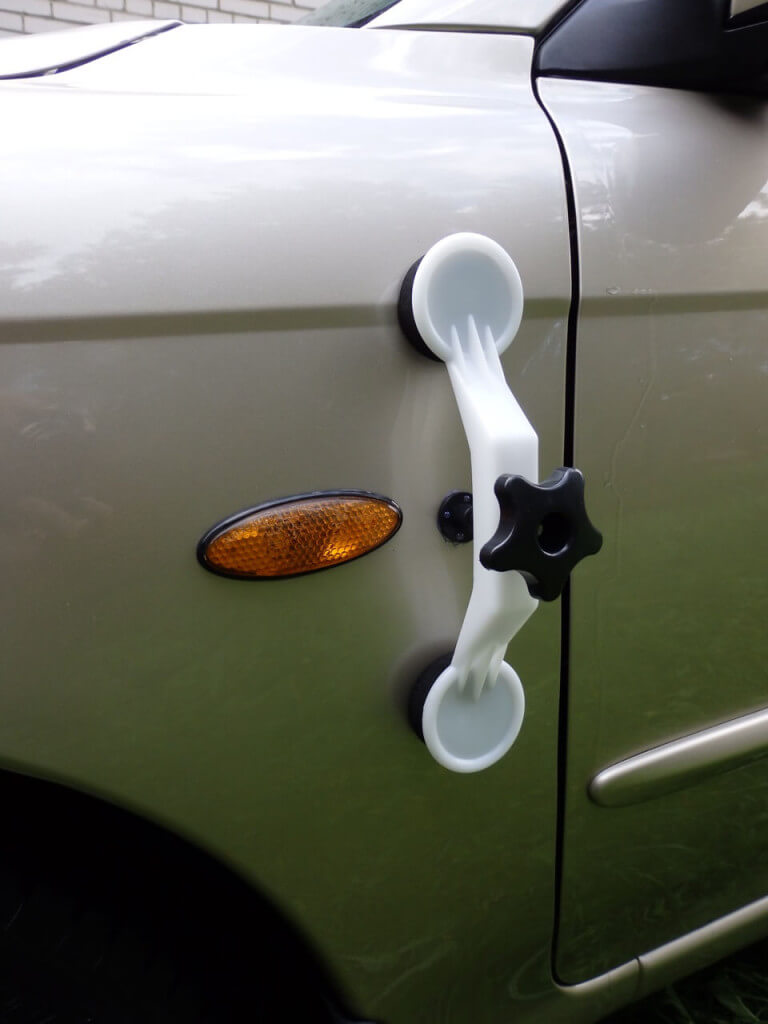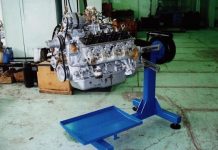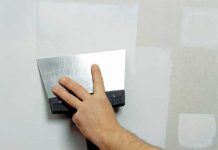Do-it-yourself body straightening does not require large costs and special skills. Even deep dents can be removed with the above methods. The main thing is to make a correction with your own hands only if you are sure of a positive result. Otherwise, it is better to consult a specialist.
During the operation of the car, scratches, chips and dents appear on the body. The reason for their appearance can be both negative environmental factors and careless driving. Chips and scratches are painted over. Repairs and pulling out dents on the machine are performed using various methods and devices to eliminate metal jams.
Before straightening a dent on a car with your own hands, you need to know what types of damage exist. Dents on a car have different shapes and degrees of damage. Small defects usually appear on the roof and hood of the car due to hail and small stones. Medium to large metal creases are a direct result of careless driving. Such dents on the car body can have a complex shape.
If the paint at the site of a large crease is covered with cracks and began to fall off, then, in addition to removing the dent, it will be necessary to restore the paintwork. Otherwise, on the part of the body where damage has occurred, foci of corrosion will form.
Repair of small dents, performs without repainting the damaged area. The defect is corrected using the PDR (paintless dent repair) technology, that is, without repainting the part being repaired. To perform work, apply:
Also included in the list of required tools is the Pops a Dent defect alignment kit. It includes nozzles, a plastic bracket, glue. Repairs are performed as follows:
The use of special equipment Pops a Dent is advisable in case of frequent dents on the car body. If defects of this plan appear rarely, it will be more profitable to use other technologies for pulling out damage.
To eliminate the deepest dent, impact pads of various shapes and hammers are used. Spoons are used as a counterfeit tool. They have different shapes and sizes, they are used depending on the type of damage.
In the center of the damage, the metal is thinner than at the edges. Before straightening, it is necessary to pull the iron to the center of the defect. For this, a gas burner is used. Next, the dents are aligned.
After rough leveling of the defect, it is covered with a putty.
Pull out the dent of the car body with your own hands, a jack will help. The device is used to repair deep damage to the fenders of a car.
Before carrying out work, dismantle the front direction indicator and headlight. From the side of the dent, the jack rests on the heel (a rubber bar is preliminarily placed under it), the device lever should rest against the opposite edge of the opening. The operation is stopped after the defect is straightened, and the damaged area is covered with a putty.
Correction of dents with a reverse hammer is performed when the driver has difficult access to the damaged area, or the parts to be repaired cannot be dismantled. Such repair of body dents usually requires the subsequent painting of the restored part. To straighten a dent, do the following:
An applicator or suction cup is only effective for straightening the body if the damage is minor. In the presence of deep and complex defects, the hammer is welded to the surface, or they cling to the technological holes using special hooks.
The process of removing a dent on a car and repairing a local section of the body is called straightening. The work, with a certain amount of experience and time, is carried out with their own hands according to the following algorithm:
Straightening of small lesions can be carried out without subsequent staining of the damaged area. With the help of reverse hammers, hooks, a hair dryer, suction cups and applicators, rubber hammers, the defect is eliminated.
If you need to fix a deep dent on a car, accompanied by creases, peeling paintwork and metal tearing, then use the following tool:
The anvils are applied to the outside of the indentation, and a rough leveling of the surface is carried out from the center with gentle blows. Spoons act as a substrate for a percussion instrument, but they are used to eliminate defects that have appeared in hard-to-reach places. After leveling, the area to be repaired is inspected. If there are metal breaks, they are welded together. Excess bulges are removed with a file. Next, you need to putty the body to level the working surface. The treated area is sanded, primed, painted and polished.
Before you putty the car body with your own hands, you need to prepare. This will help to avoid visible defects after painting the car:
In the presence of more serious damage, removing the dents will not help restore the integrity of the part. In this case, the body element, or its most severely damaged part, is replaced with a new one. When replacing, it is necessary to find a part identical to the one being replaced. If a certain area is replaced, then the patch is cut out of the same metal. Then it is welded to the part to be restored.
VIDEO
Minor damage to the body, chips, scratches and dents on the car can be repaired by yourself without repainting. The previously undamaged parts of the case are subject to restoration. If paint cracks, cracks and bends appear, repairs without painting will not work.
Removing dents after hail Is a completely solvable problem for every car owner whose car has been exposed to this atmospheric phenomenon. For this, one of four methods of paintless body repair can be used. Each of them has its own advantages and disadvantages, as well as the level of complexity of their implementation. In addition, they use different tools that should be available from the masters. We will discuss these repair methods in detail below.
The procedure for removing dents without painting is fundamentally different from body repair with restoration of paintwork. Indeed, in the case of the latter, the car body is partially disassembled, which requires a significant amount of time and effort. The process of removing dents takes place directly on the body without the need to dismantle its individual parts. Currently, specialists use four main methods:
All of them relate to the so-called PDR-methods, that is, paintless dent removal methods (Paintless Dent Removal - eng.). Let's analyze each of them separately:
Lever method - the most popular at the service station, since it involves the use of special levers. Performing repairs can sometimes be difficult because there is no way to position the levers directly under the affected areas of the machine body. In addition, often, in order to get to individual surfaces of the body, it is necessary to dismantle the interior trim elements or technological mechanisms.Glue method carried out with the help of special tools that literally pull the dented surface back. To do this, special caps are glued to the damaged area, which are subsequently pulled upward, and they, in turn, pull the surface of the body behind them.Vacuum method ... This method is similar to the glue method. Its only difference is that vacuum suction cups are used instead of glued caps.Thermal method Removing dents after hail without painting is based on sharp heating of the damaged surface with its subsequent sharp cooling. As a result of this approach, the body is deformed and takes on its original shape. They are usually heated with a building hair dryer and cooled with compressed air.Lever dent removal hooks
This method is most common at service stations. It works best on large surfaces, located away from stiffeners ... To perform the procedure, special tools are used - long levers, with one end of which they pointwise act on the dents from the inside.
If a dent has formed in a place where there is a stiffener on the inside, then there is an option when the sealant on which the amplifier is fixed is heated with the help of a construction hair dryer, after which it is folded back, giving access to the damaged surface from the inside. Further, the procedure is carried out in the same way.
Whole sets of dent removal levers are now commercially available. They can include from 10 to 40 (and sometimes more) different hooks and levers, with which you can remove most of the dents on the surface of the car body. However, in fairness, it should be noted that a private car owner will not need such sets. After all, they cost a lot of money, and they will have to be used, to put it mildly, rarely. Therefore, they are more suitable for professional service stations.
However, if you do have such leverage, then you can try to complete the repair procedure yourself. The process depends on the specific situation and the degree of damage, however, on average, the following algorithm is applied:
Thoroughly wash the surface of the body in order to better see the level of damage to the paintwork (if any), as well as the depth of the dent.
Correction panel for removing dents
Before performing the described procedures yourself, it will be useful for you to practice on some old body parts. The process is simple, but requires some skill.
It should be noted right away that these methods can be used only if when the integrity of the paintwork is not compromised at the point of deformation ... If there are chips or scratches, then you need to get rid of them. You can read how to do this in a separate article on our website. The fact is that the tools described below have a strong mechanical effect on the surface, which can cause delamination of the paintwork.
To remove dents from hail with your own hands using the glue method, you need the following tools:
Dent Removal Kit
minilifter (also called a reverse hammer);
glue fungi (pistons) of various diameters;
glue;
glue heat gun;
liquid for removing glue residues;
hammer;
blunt-tipped Teflon core.
Tips on how to properly perform car body repair with your own hands. TOP 10 common mistakes when performing body repair.
Repair of dents without painting. Educational film
Is there a small dent on the body of the car? Watch the instructional video demonstrating how to gently correct the deformation using the suction cups without further painting.
Technology for repairing dents without painting
One of the PDR technologies is the use of “fungi”. By gluing small suction cups with a hard center but soft edges, you can quickly pull out a dent without painting. The wizard will show and tell with a visual demonstration
Removing hail dents glue method is performed according to the following algorithm:
Adhesive method for removing dents
First, the body must be washed, and the damaged area must be degreased. This can be done using various means - alcohol or white spirit (do not use solvents for degreasing, as they can damage the paintwork ).
Glue is applied to the piston of the required diameter, after which it is installed in the center of the recess on the body.Leave for about 10 minutes to allow the glue to dry.
After that, you need to take a minilifter or clamp and place the other edge of the piston in its groove. First, you need to tighten the upper screw in order to exclude its free movement.
Next, they begin to clamp the handle of the device. In this case, a smooth leveling of the surface of the damaged area of the body occurs.
When the work is completed, the piston comes off, and the remaining glue is removed with the existing liquid.
Removing dents using the glue method
As a rule, after performing the procedures described above, a bulge remains with a depression in the center. You also need to get rid of it - using a fluoroplastic or Teflon core with a blunt tip by gently tapping on the edges of the bulge. After that, the bulge will disappear, instead, a dent with a smaller diameter will appear. To remove it, you need to follow the steps described in paragraphs 1-5 of the previous list, however using piston of smaller diameter ... In some cases, the procedure will need to be carried out three or more times in a row to completely eliminate the defect on the machine body.
Work vacuum method is similar in general terms to the method described above. The sequence of work will be as follows:
Using a suction cup to remove dents on the body
Wash the surface of the car body and remove all debris and small particles from the places where the dent is located.
Place the suction cup on the dent to be repaired.
Lock the suction cup in place (some models have special devices that allow you to move the suction cup over the body surface).
Evacuate all air between the suction cup and the body, thus ensuring a high vacuum level.
After fixing the suction cup in place, you need to pull on it. Depending on the specific model, you can pull directly on the suction cup body, or you can rotate a special threaded handle.
The suction cup will move and pull the surface of the machine body with it.
The vacuum method for removing hail dents is the most gentle on the paintwork of the machine ... Therefore, if the paintwork of your car is not of the best quality or it has been applied for a long time, then the vacuum method will suit you better than others.
The leveling process in this case involves heating the damaged area of the body to a high temperature, followed by cooling, for which special means are used. It should be noted right away that exposure to high temperatures has a detrimental effect on the body paintwork. Therefore, after returning to its geometry, it is often necessary to re-paint the treated area.
A powerful building hair dryer is often used to heat the metal. And for cooling - the flow of cold air from the compressor.
The thermal repair method is ineffective for very large and small, but deep damage. With it, you can only get rid of medium-sized dents that have a small depth. Moreover, using such a method may not always lead to the desired results ... The fact is that it all depends on the thickness and grade of metal from which the car body is made. If it is thick enough, then even heating it to a significant temperature, you will not achieve a satisfactory result. Therefore, the thermal method of removing dents from hail is rarely used.
The first thing the owner of a car that has been damaged by hail should keep in mind is what is needed carry out repair work as quickly as possible ... Metal has a "memory", due to which, after a long time, deformation will be accepted on a permanent basis, and it will be difficult to return to its original appearance.
The most convenient ways to remove dents with your own hands - it is glue and vacuum. However, to complete them, you need to buy the tools and materials described above.In addition, inexpensive dent removal kits have 2-3 pistons, which are sometimes not enough to repair small diameter damage. A the most effective method is lever ... However, we do not recommend that you do it yourself without proper skill, it is better to seek help at a service station.
Every car enthusiast knows where the smallest scratches and damages are located on his car, especially if it is the latest model. But few realize that these defects can be corrected by bringing the car to its original state in a few minutes. Modern technologies make it possible to repair car dents without painting fundamental work in preparation for it - puttying, stripping, priming.
Removing dents on a car without painting is carried out mechanically, by straightening the body curvatures formed under the influence of impacts as a result of an accident or in another way. Mechanical restoration of the car's appearance has become possible due to the high quality of materials used in the production process. Modern paints and varnishes have increased hardness in combination with elasticity, therefore, in most cases, under extreme loads (with crushing and further straightening of the metal base), they do not break, do not crack.
The automotive industry in recent decades has used a thinner metal that is easy to flatten. In addition, stamped metal has a "shape memory" - the ability to return to the state that it was originally given. Thanks to these features of modern materials, it became possible to remove the dent without paint and restore the previous state of the car by the method of mechanical alignment of the body. The technology came to the Russian market from the west. The advantages of this method are obvious:
it is effective - 100% restoration of appearance occurs;
the technology of repairing dents without painting provides for long duration of procedures: to straighten a dent on a car, it takes from 15 minutes to 2 hours, depending on the size and complexity of the damage;
the method is economical - such a repair of dents on a car is cheaper than the usual putty-painting method, especially if the car owner has mastered the technique and can level the surface on his own;
a high-quality result is achieved;
the car body is processed in a sparing mode.
When is it possible to remove a dent without painting?
Removing dents on a car without painting is possible only if several conditions are met:
previously, the car was not repaired in this place: it was not damaged or restored;
no end-to-end destruction of the metal of the machine;
the paintwork is not damaged - it is preserved intact, without breaks, deep cracks to the base, chips;
car not older than 15 years.
Removing dents on a car without painting affects the size of the bent area - if the above conditions are met, large defects can also be corrected by this method.
Due to the design features of the car, it is impossible to remove the dent without painting with your own hands in hard-to-reach places:
on the thresholds under the doors;
along the edges of the trunk parts;
on the roof pillars.
To access the damage from the inside, it may be necessary to completely or partially remove the trim in the passenger compartment.
The name of the method literally translates from English (Paintless Dent Repair) - paintless removal of dents, in speech the name is often used in the form of an English (PDR) or Russian (BUV) abbreviation.
The PDR formula - removing dents on a car body without painting - is as follows: tool plus technology equals “massage” of the bent car body with the result of complete “healing”.
The main feature of the method is that the alignment of dents on the machine requires special equipment (albeit inexpensive) and experience with it. The good news is that the technology is not difficult, so you can fix defects in your own garage using DIY tools for removing small dents.
The listing of the instruments used forms a long list:
hammer;
bump stop;
mini lifters;
mallet;
levers;
hooks;
hot melt applicators;
vacuum suction cups;
hairdryer;
magnets.
Buying a professional PDR tool requires a lot of money and is sold in sets. But many adaptations are easy to make on your own. The tools are designed to act on the damaged surface from both sides, so it is important to provide access to the curvature from both the outside and the inside. On the outside, the dent is pulled out using vacuum devices or an adhesive bond that provides adhesion to the surface, and on the inside, it is straightened by pressing movements.
Repair of small dents without painting involves an exclusively mechanical method of affecting damage, for which different methods can be used using compressed air and pressure drops, magnets, thermal heating, shock and force action.
Removing dents without painting at home is a profitable measure - it does not require the cost of consumables. Although the initial costs of purchasing equipment and training cannot be avoided, in the future, with the skills, you can remove dents on the car with your own hands within half an hour. However, it will take a skill to get it up to a mastery level.
Advice. To carry out body repairs in PDR equipment, you need to develop a skill and bring it to automaticity, but it is worth acquiring these skills: modern cars made of thin steel wrinkle easily. It is quite expensive to contact the service station every time, and the ability to correct the defect will save time, nerves and money.
The preparatory stage for removing small dents without painting with your own hands includes the purchase of a set of tools, protective equipment and preparation of the workplace. The initial technological basics should be acquired by aligning unnecessary blanks-body parts.
Before starting work, wash and dry the surface of the car.
In places of bending, stress is preliminarily removed - they are tapped along the borders with a hammer, placing a metal sheet.
Next, you yourself need to straighten the dent on the machine by pulling it out using a vacuum suction cup or an applicator with glue. When returning to its original position, the metal will emit a characteristic click.
You can completely remove the dents on the car with your own hands after mechanical tapping on the back side. To do this, you need a set of tools - levers, hooks and access from the inside of the body.
In the process of work, the size of the damage must be taken into account - large and small dents on the car body require different-sized devices. For damage that takes up a significant area, a large-diameter vacuum suction cup is required, and for small-sized ones, small adhesive applicators and a bump stop.
The alignment of dents without painting with your own hands is controlled only "by eye", no devices for determining the evenness of the surface and the quality of the manipulations performed are not provided.
For the accuracy of visual control in the process of repairing dents on a car with their own hands, they use the effect of glare from light sources - a flat surface reflects light evenly.
Sometimes a cosmetic painting of certain areas may be required, hiding scuffs or scratches, it is better in such cases to use car enamels in aerosol cans.
With the modern rhythm of life, when the car is used almost as often as one's own legs, and the number of unforeseen situations on the roads, injuries, and car blows is growing, mastering the BUV method - removing dents without painting pdr - can become a tool that saves a large amount of your own time and money.
Dents can appear on the body of any car, even if it is owned by a neat and professional driver. The causes of defects can be different: collisions with curbs and other fences, traffic accidents, falling icicles, vandalism, etc. But at the same time, in order to solve the problem that has arisen, it is not necessary to resort to expensive service station services, since in most cases you can fix the problem yourself.
It is recommended to inspect the body for defects outdoors, in bright daylight. Only in these conditions will the flaws be clearly visible.
Before removing dents, you must also make sure that the paintwork is intact, otherwise there will be no point in carrying out the manipulation.
Over the past two decades, almost all car manufacturers have been painting cars with paint with polymer components in the composition, which allow the paintwork to stretch along with the metal.
Therefore, if your car is older, most likely it will not work to remove the dent with a non-paint method - the car will still need painting. In this case, it is quite possible to apply the classic straightening.
Today, PDR technology is very popular, which allows you to remove dents without painting. It is used for minor deformations of the body, with an intact paintwork.
It is unacceptable to use this method when
Car painting with low quality paint;
Deep dents on the body, which will indicate the constriction of the metal;
Repair the damaged area using a primer mixture;
The appearance of cracks and chips on the surface of the paintwork;
In addition, PDR is often ineffective for damaging sills, pillars, bonnet edges, doors and trunk.
Dent Removal Tools are available from specialized stores.
1)
2) ... After the type of damage is established, we select the most suitable lever in a particular case. Further, with the help of a tool inserted into a suitable technological hole, we exert a force on the damaged body from the inside, which, by creating a pressure drop, will return the metal to its original shape.
3) ... As noted above, dents can also be located in hard-to-reach areas. In this case, it will be impossible to solve the problem using specialized hooks. Here you will need to use a minilift or a vacuum hood.
4) ... With the help of a minilifter it is possible to remove dents, the diameter of which does not exceed 1-2 cm. The supports of this tool are slotted, and therefore scratches during its use are practically excluded. The kit also includes plastic adapters of different shapes, which are attached to the damaged surface with thermal glue.
5) ... Next, we install a minilifter on the body, the grip of which is securely attached to the adapter, after which, using the adjusting screw, we pull the grip up. Next, use the handle to slowly raise the adapter until the body geometry is fully restored.
Remember!
How to remove deep dents and deformations, which are accompanied by chips and peeling of the paintwork? In this case, you will have to use a straightening hammer, with attachments of various sizes and an anvil capable of supporting the thin sheet metal of the body during restoration of its geometry.
In the process of work, the outer part of the deformed body should be on an anvil, the surface of which is covered with a cloth, which will prevent the formation of defects on the paintwork of the part.
The straightening process itself begins from the center of the dent (on the inner side of the damaged area) and gradually move to the edges of the defect. In this case, the blows should not be too strong, since excessive impact on the metal will lead to its thinning.
And at the final stage, we eliminate damage and paint chips by means of putty, sanding, priming and painting of the problem area.
VIDEO
Car preparation.
one). We find dents on the car
2). Exploring the dents
The maximum result with this method can be obtained when used on small dents, without large folds or damage to the paint, with a surface area of at least 8 cm.
3). Preparing everything you need to remove dents
Heating and cooling of the straightened section.
one). Warming the panel with a dent . We turn on the hairdryer and direct the stream of hot air (for one to two minutes) to the dent and to the surface adjacent to it.
We turn on the hair dryer in the middle position and place it at a distance of 13 - 18 cm from the surface of the car. Make sure that the surface does not overheat, otherwise you can damage the paint with heat.
2). We isolate the damaged area of the straightened surface (if possible)
3). We put on thick protective gloves
4). We use dry ice or liquefied compressed air
In cases of using dry ice, we take a block in one hand, and then gently wipe the surface with a dent through aluminum foil.
When using a can of compressed air, turn the can upside down and spray on the surface with a dent, which will cover this area with a layer of liquid ice. Some basic scientific principles work here: the interaction of pressure, volume and temperature of a gas. In normal use, the temperature of the cylinder drops as the gas escapes, and if the cylinder is turned upside down, it will self-cool.
This method requires only short-term use. In most cases on modern cars, the outer panels are made of a relatively thin and lightweight material that cools quickly enough. Changes can be seen in about 30-50 seconds.
5). Waiting for a while
In cases where dry ice has been used, the aluminum foil will need to be removed after the dent has been removed.
If liquid ice was used with the help of compressed air, then we wait until the white foam evaporates from the surface of the car, after which we wipe its remnants with a soft cloth.
6). Repeat the process as needed
VIDEO
To remove dents from the car body, you need a strong enough magnet. At the same time, it is possible to perform this task with your own hands without painting only if the dent is shallow without creases in the edges, the so-called "popping".
1)
2) . We bring the magnet to the edge of the dent and pull it towards ourselves.
3)
The first reason lies in the incredible speed of repair. With the usual method, this will take about 2 days. Moreover, this does not depend on the complexity of the work, since it will take a lot of time to remove a small dent. And thanks to the above methods, it will take about an hour to remove a small dent, and in some cases even less.
The second reason is that no additional action is required from you. That is, immediately after leveling the surface, the car is ready for use.
Third reason is good quality. In many cases, additional painting will not be required. That is, the damaged area is restored along with the native paintwork.
Fourth reason lies in the favorable cost. Full repair and subsequent painting of the car will cost much more.
I would also like to note that all of the above methods are quite effective for removing small dents on their own, but none of these methods guarantees that paint will not burst on the car body during work.
Video (click to play).
You still have to fork out for equipment. In addition, it is not a fact that the work will turn out to be done with sufficient quality. I think it will be better if the work is entrusted to the masters.

